Nature is a still place where we can practice mindfulness. As I think about going back to teaching next fall I struggle with the idea of how to bring mindfulness to the classroom.
More than that, I struggle with the concept of bringing 25 college students, all non-science majors, into a space where observation, reflection, and critical thinking are meaningful laboratory activities.
High spirited, busy, noisy, my students are nice people who don't have much interest in what I have to teach. It's been a long time though since I thought of myself as a "science" teacher. Instead I look at my job as a way to engage students in thinking critically about abstractions. To me this pursuit requires a kind of focus, a mindfulness that allows room for contemplation.
Nature looks "concrete" enough. You've got your water. Youve got your soil. You've got your plants. But what about all the underlying complexity? The electrons, the cellulose, the bacteria, the proteins, the branching patterns? As a botanist I trained myself to look deeply whether in the field, the library, or staring into the eyepiece of a microscope. Many quiet moments, many missed weekends, and a love for what I was doing brought me to some understanding of science.
I was in my 30s and 40s when I tackled this challenge, decades and in some ways, worlds away from my current crop of undergraduates. Nevertheless we are together in a classroom where we share ideas, and to some extent, common goals.
I've managed to bring a kind of centering to my lectures. Visitors comment on the quiet concentration at work there. But what about lab? A place of play, a noisy place, a place to bring out the cell phones and use them "as a force of good and not evil" as we find new ways to engage new thinkers in our quest for an understanding of nature.
How to introduce mindfulness to that space without squelching enthusiasm? How to bring a joy of discovery without prescribing recipes? How to encourage critical thinking about abstract concepts, and make something tangible and useful through the process of exploration and learning?
Wednesday, January 30, 2013
Wednesday, January 16, 2013
Urban Form and Biodiversity
Just spent a couple of inspiring days with our new students and faculty at the Boston Architectural College Masters in Sustainable Design intensive. Lots of discussions on the table and lots of good opportunities to explore Boston and its neighborhoods, all dedicated to the topic of sustainable design.
As a biologist one of my main concerns has to do with biodiversity in the city. How can we accomplish it? How can we maintain it? How can we enhance biodiversity in urban settings?
At first glance it would seem that biodiversity and cities are two concepts that don't mix. The endless ribbons of concrete, asphalt, brick, and sidewalk of the city, along with the darkening shadows between buildings, the dry alleyways, salted streets...none of these are conducive to life forms. Or are they?
It is important to remember first of all that all kinds of microbial organisms inhabit our cities, the same as they thrive in our bodies. Fungi and bacteria abound, all of them taking advantage of hidden crevices where nutrients may be present. These invisible or nearly invisible organisms provide a kind of basis for everything else in the ecosystem. They break down and channel waste. They make nutrients available. They are pioneer species that live in those truly lifeless corners, forming soil, retaining moisture, and creating habitat.

After these, the small things, mosses, algae, and grasses take their place in the urban ecosystem. Like the fungi and bacteria these small guys live in corners, cracks in the pavement, chinks in the brick, breaks in the asphalt. The ones that establish themselves in the city don't have very specific habitat requirements. They can tolerate extremes of heat, dryness, wind, and, ironically, shade. The city is a harsh environment but not impossible.
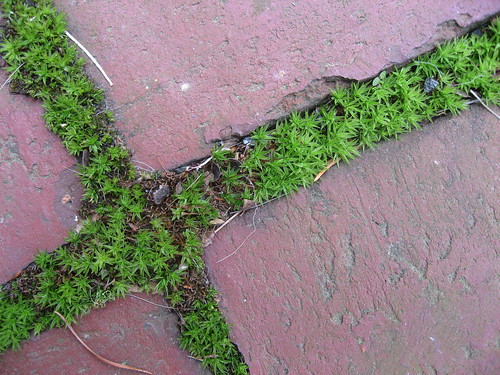
What we call "weeds" are next on the succession of urban habitats. Larger plants, usually flowering plants of one sort or another fill this ecological space. Often they are found on small plots of soil, verges between the street and sidewalk. Members of the families Chenopodiaceae (like lambs' quarters) or Compositae (dandelions, asters, and a hundred other species) or Scrophulariaceae (Verbascum, eggs-and-butter, etc.) tend to thrive here. Most but not all of these species are annuals, plants that live out their lives in a single season. They are common to desert habitats and other seasonally dry or cold places, where life is harsh but not impossible. They are able to germinate, grow, and set seed in a single season and many of these, biennials or semi-perennials, can be seen in late fall or early winter setting out small rosettes of new leaves that will give the plant a head start in the spring. Because these plants are highly fertile they their seeds (and pollen) are found almost everywhere and they are able to colonize new urban environments as they become available. Speaking of biodiversity these plants provide habitat and nutrition for all kinds of insects, many of them beneficial, that in turn provide nutrients for vertebrates we value, such as birds.
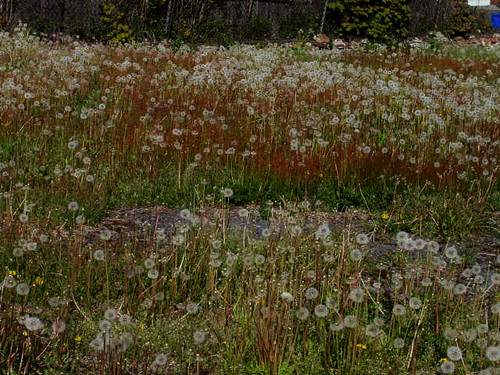

Urban trees are of course the great providers. The bless our urban habitats with shade, with leafy greens, and with a kind of orienting form with their branches and trunks. In the trees live all kinds of vertebrates, some of them pesty like squirrels and others more "natural," like hawks and even owls, that control the squirrels and pigeons and help keep our neighborhoods free of pests like mice and rats. The trees are home to all kinds of birds, they provide wet hideouts in their bark for lichens and mosses, and their leaves, when we allow them to molder, provide nutrients for our urban soils.
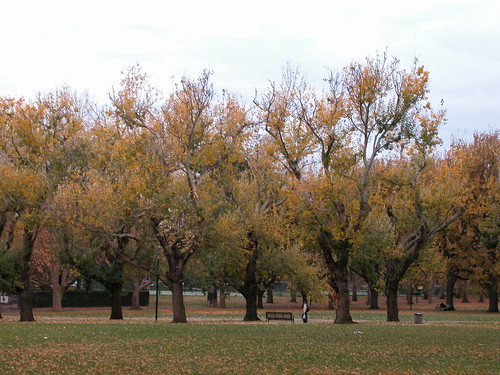
Trees cool the environment, they provide noise abatement, and to an extent they add oxygen to the atmosphere. Properly maintained trees and the green spaces they grow on help to control storm water, directing it to the soil instead of straight into sewers. They help to produce soil, which filters some of the toxins out of runoff and provides substrate for other plants. If you fly above our cities you can see that trees make the older parts of cities look like jungle islands while the suburbs, radiating out in their sprawl, look relatively barren.

We need to keep planting and nurturing trees in our urban environments. And it behooves us to maintain whatever natural spots we have in the city. Reducing lawns and replacing them with shrubs, small trees, or other plants is also a good way to reduce our dependence on irrigated green spaces, as well as unnecessary fertilizers and pesticides.

My students are working on urban plans right now. Yesterday I had the delight of going over some of their plans with them. Featured heavily in these plans are green walls, green roofs, enclosed gardens, and living "machines," all expensive interventions that require a large amount of infrastructure and maintenance. My students are always a little taken aback when I point out the kind of common sense biodiversity that we already have in the city. They are aghast I think when I mention some of the potential problems in maintaining properly functioning green roofs and other high-profile architectural interventions. But I think it's important to start at the small, almost invisible level of urban biodiversity, to understand the dynamics of that ecosystem, before we pour on the investment-heavy interventions.
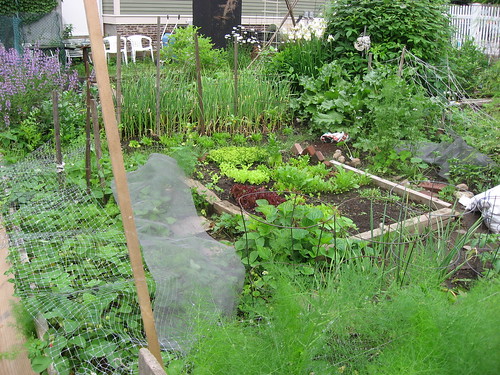
Urban gardens, community victory gardens, even window boxes all have their place in making our urban spaces diverse biologically. At the same time, these low-key interventions provide water-cleansing and conservation services, mitigation of the urban heat island effect, and an living environment that "fits" the rough habitat of the city at very low cost. These small green interventions bring biodiversity to the human scale. They provide us with real nature we can interact with. And they encourage and permit us to be mindful of our environment by feeling it, touching it, and smelling it.
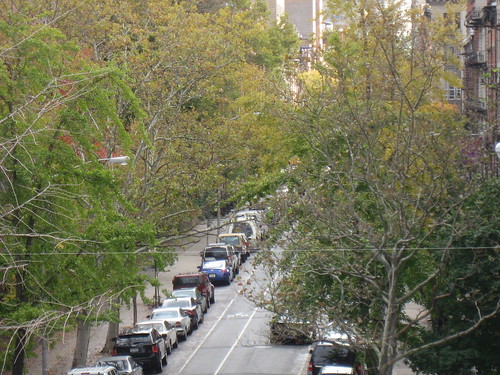
As a biologist one of my main concerns has to do with biodiversity in the city. How can we accomplish it? How can we maintain it? How can we enhance biodiversity in urban settings?
At first glance it would seem that biodiversity and cities are two concepts that don't mix. The endless ribbons of concrete, asphalt, brick, and sidewalk of the city, along with the darkening shadows between buildings, the dry alleyways, salted streets...none of these are conducive to life forms. Or are they?
It is important to remember first of all that all kinds of microbial organisms inhabit our cities, the same as they thrive in our bodies. Fungi and bacteria abound, all of them taking advantage of hidden crevices where nutrients may be present. These invisible or nearly invisible organisms provide a kind of basis for everything else in the ecosystem. They break down and channel waste. They make nutrients available. They are pioneer species that live in those truly lifeless corners, forming soil, retaining moisture, and creating habitat.

After these, the small things, mosses, algae, and grasses take their place in the urban ecosystem. Like the fungi and bacteria these small guys live in corners, cracks in the pavement, chinks in the brick, breaks in the asphalt. The ones that establish themselves in the city don't have very specific habitat requirements. They can tolerate extremes of heat, dryness, wind, and, ironically, shade. The city is a harsh environment but not impossible.

What we call "weeds" are next on the succession of urban habitats. Larger plants, usually flowering plants of one sort or another fill this ecological space. Often they are found on small plots of soil, verges between the street and sidewalk. Members of the families Chenopodiaceae (like lambs' quarters) or Compositae (dandelions, asters, and a hundred other species) or Scrophulariaceae (Verbascum, eggs-and-butter, etc.) tend to thrive here. Most but not all of these species are annuals, plants that live out their lives in a single season. They are common to desert habitats and other seasonally dry or cold places, where life is harsh but not impossible. They are able to germinate, grow, and set seed in a single season and many of these, biennials or semi-perennials, can be seen in late fall or early winter setting out small rosettes of new leaves that will give the plant a head start in the spring. Because these plants are highly fertile they their seeds (and pollen) are found almost everywhere and they are able to colonize new urban environments as they become available. Speaking of biodiversity these plants provide habitat and nutrition for all kinds of insects, many of them beneficial, that in turn provide nutrients for vertebrates we value, such as birds.


Urban trees are of course the great providers. The bless our urban habitats with shade, with leafy greens, and with a kind of orienting form with their branches and trunks. In the trees live all kinds of vertebrates, some of them pesty like squirrels and others more "natural," like hawks and even owls, that control the squirrels and pigeons and help keep our neighborhoods free of pests like mice and rats. The trees are home to all kinds of birds, they provide wet hideouts in their bark for lichens and mosses, and their leaves, when we allow them to molder, provide nutrients for our urban soils.

Trees cool the environment, they provide noise abatement, and to an extent they add oxygen to the atmosphere. Properly maintained trees and the green spaces they grow on help to control storm water, directing it to the soil instead of straight into sewers. They help to produce soil, which filters some of the toxins out of runoff and provides substrate for other plants. If you fly above our cities you can see that trees make the older parts of cities look like jungle islands while the suburbs, radiating out in their sprawl, look relatively barren.

We need to keep planting and nurturing trees in our urban environments. And it behooves us to maintain whatever natural spots we have in the city. Reducing lawns and replacing them with shrubs, small trees, or other plants is also a good way to reduce our dependence on irrigated green spaces, as well as unnecessary fertilizers and pesticides.

My students are working on urban plans right now. Yesterday I had the delight of going over some of their plans with them. Featured heavily in these plans are green walls, green roofs, enclosed gardens, and living "machines," all expensive interventions that require a large amount of infrastructure and maintenance. My students are always a little taken aback when I point out the kind of common sense biodiversity that we already have in the city. They are aghast I think when I mention some of the potential problems in maintaining properly functioning green roofs and other high-profile architectural interventions. But I think it's important to start at the small, almost invisible level of urban biodiversity, to understand the dynamics of that ecosystem, before we pour on the investment-heavy interventions.

Urban gardens, community victory gardens, even window boxes all have their place in making our urban spaces diverse biologically. At the same time, these low-key interventions provide water-cleansing and conservation services, mitigation of the urban heat island effect, and an living environment that "fits" the rough habitat of the city at very low cost. These small green interventions bring biodiversity to the human scale. They provide us with real nature we can interact with. And they encourage and permit us to be mindful of our environment by feeling it, touching it, and smelling it.

Tuesday, January 8, 2013
Oxygen, Carbon Dioxide, Decomposition, and Renewal
A blog is a deeply personal mode of expression. Having stated this patent truth I have to say how much better I feel after a brisk walk. It's the dead of winter as I write, a nice but windy day in the 40s, too uncomfortable I think, for a bike ride. These winter days I'm stuck inside and it is real torture, as well as a frustrating damper to the work I'd like to be doing. I need oxygen!
And so, as it turns out, do most of the life forms we are acquainted with. Since the "oxygen revolution" that occurred about 3.5 billion years ago as a result of photosynthesis, multicellular organisms, animals, plants, and fungi, depend on oxygen. Our every cell is host to multiple bacteria, mitochondria, whose energy-generating mechanism requires the electron-hungry presence of oxygen in order to function. We supply the mitochondria with sugars that they break down. The mitochondria harvest electrons from the breakdown of those sugars. And they channel the movement of electrons to produce energy. Oxygen, which we also provide, sops up excess electrons and allows the mechanism to run. So in a way oxygen = energy.
Mitochondria give off carbon dioxide as part of their function, a sort of by-product of processing electrons. And carbon dioxide is where our discussion is going. It's common knowledge that excess carbon dioxide is warming our planet. The question is not if, but when we will have to cope with the consequences. Super storms, excessive drought, and record-breaking heat waves suggest that we have already begun to feel the effects of global warming. Melting glaciers and disappearing ice at the poles, both well-documented phenomena, are further evidence of global warming. The result is ever-raising sea levels. Carbon dioxide is the initiator, if not the major player in these phenomena.
But if mitochondria have been giving off carbon dioxide naturally for billions of years, what is the cause of the sudden rise in this greenhouse gas?
Plant and animal life, both present on the planet for these billions of years, have experienced a continuous cycle of decay and regeneration. Things die. And they rot. They are degraded by bacteria, fungi, and other organisms that break down their dead bodies, giving off carbon dioxide in the process. Any ecosystem is in a constant state of releasing carbon dioxide as part of its natural function, even tropical rainforests.
Some of the creatures that have died over the eons, in fact a lot of them, have ended up buried under sedimentary materials before they rotted away. Over millions and millions of years these dead organisms have been squished so hard, over such a long period of time, that they are unrecognizable today. They have turned into coal, gas, oil, and tar- the things we use as "fossil fuels."
One of the amazing things about fossil fuels is that they are composed largely (or primarily) from carbon. This is not surprising. Our bodies, once you get rid if the water, are mostly carbon. And if you think of wood, which burns nicely once it's dry, its component parts of cellulose and lignin (both highly flammable) are carbon-based.
So fossil fuels and carbon? What does this have to do with global warming? Why now?
Until the advent of the industrial revolution, most of the energy humans used was derived from their own bodies, from animals, from wood, water, and semi-fossilized deposits of peat. It wasn't until about 200 years ago that we started mining coal, which was used to heat our houses, run our large-scale industries, and create steam to move ships and trains. Still, that use of coal was limited to industrially developed societies, a relatively small segment of the earth's human population.
Internal combustion engines in cars changed that scenario in a revolutionary way. Thousands, then millions, and now billions of cars run on fossil fuel- derived oil. In the past fifty years a true explosion of carbon has entered the atmosphere thanks to the combustion (burning) of unprecedented reserves of carbon-based fuel. This explosion has been fed as well by the use of fossil fuels for generating heat, electricity, and refined fuels for air transport. What we perceive as a sort of steady-state level of consumption, a constant burning of oil, gas, and coal at the global scale, has been a reality for perhaps a human generation, barely more.
The removal and combustion of previously sequestered (buried) fossil fuels during these past few decades has resulted in an enormous rise in atmospheric carbon dioxide in levels that are new to the planet.
A small amount of that carbon dioxide is absorbed through photosynthesis in the oceans and extant forests. But the ability of these ecosystems to absorb carbon dioxide is limited by their biological capacity and by their limited ability to expand. Part of the problem of deforestation is that we are limiting that absorptive ability further.
There is no question then that when I feed my compost worms, take a walk, or even plant things in the garden, I am contributing carbon dioxide to the atmosphere. Almost all living systems give off carbon dioxide. But that level of emissions is gradual, measured, and biologically limited. The growth in carbon dioxide in our contemporary atmosphere is due to an explosion in emissions. And by definition explosions are sudden, uncontrolled, and potentially unlimited. Rather than a linear increase in carbon dioxide we are experiencing one that is exponential, and potentially out of control.
And so, as it turns out, do most of the life forms we are acquainted with. Since the "oxygen revolution" that occurred about 3.5 billion years ago as a result of photosynthesis, multicellular organisms, animals, plants, and fungi, depend on oxygen. Our every cell is host to multiple bacteria, mitochondria, whose energy-generating mechanism requires the electron-hungry presence of oxygen in order to function. We supply the mitochondria with sugars that they break down. The mitochondria harvest electrons from the breakdown of those sugars. And they channel the movement of electrons to produce energy. Oxygen, which we also provide, sops up excess electrons and allows the mechanism to run. So in a way oxygen = energy.
Mitochondria give off carbon dioxide as part of their function, a sort of by-product of processing electrons. And carbon dioxide is where our discussion is going. It's common knowledge that excess carbon dioxide is warming our planet. The question is not if, but when we will have to cope with the consequences. Super storms, excessive drought, and record-breaking heat waves suggest that we have already begun to feel the effects of global warming. Melting glaciers and disappearing ice at the poles, both well-documented phenomena, are further evidence of global warming. The result is ever-raising sea levels. Carbon dioxide is the initiator, if not the major player in these phenomena.
But if mitochondria have been giving off carbon dioxide naturally for billions of years, what is the cause of the sudden rise in this greenhouse gas?
Plant and animal life, both present on the planet for these billions of years, have experienced a continuous cycle of decay and regeneration. Things die. And they rot. They are degraded by bacteria, fungi, and other organisms that break down their dead bodies, giving off carbon dioxide in the process. Any ecosystem is in a constant state of releasing carbon dioxide as part of its natural function, even tropical rainforests.
Some of the creatures that have died over the eons, in fact a lot of them, have ended up buried under sedimentary materials before they rotted away. Over millions and millions of years these dead organisms have been squished so hard, over such a long period of time, that they are unrecognizable today. They have turned into coal, gas, oil, and tar- the things we use as "fossil fuels."
One of the amazing things about fossil fuels is that they are composed largely (or primarily) from carbon. This is not surprising. Our bodies, once you get rid if the water, are mostly carbon. And if you think of wood, which burns nicely once it's dry, its component parts of cellulose and lignin (both highly flammable) are carbon-based.
So fossil fuels and carbon? What does this have to do with global warming? Why now?
Until the advent of the industrial revolution, most of the energy humans used was derived from their own bodies, from animals, from wood, water, and semi-fossilized deposits of peat. It wasn't until about 200 years ago that we started mining coal, which was used to heat our houses, run our large-scale industries, and create steam to move ships and trains. Still, that use of coal was limited to industrially developed societies, a relatively small segment of the earth's human population.
Internal combustion engines in cars changed that scenario in a revolutionary way. Thousands, then millions, and now billions of cars run on fossil fuel- derived oil. In the past fifty years a true explosion of carbon has entered the atmosphere thanks to the combustion (burning) of unprecedented reserves of carbon-based fuel. This explosion has been fed as well by the use of fossil fuels for generating heat, electricity, and refined fuels for air transport. What we perceive as a sort of steady-state level of consumption, a constant burning of oil, gas, and coal at the global scale, has been a reality for perhaps a human generation, barely more.
The removal and combustion of previously sequestered (buried) fossil fuels during these past few decades has resulted in an enormous rise in atmospheric carbon dioxide in levels that are new to the planet.
A small amount of that carbon dioxide is absorbed through photosynthesis in the oceans and extant forests. But the ability of these ecosystems to absorb carbon dioxide is limited by their biological capacity and by their limited ability to expand. Part of the problem of deforestation is that we are limiting that absorptive ability further.
There is no question then that when I feed my compost worms, take a walk, or even plant things in the garden, I am contributing carbon dioxide to the atmosphere. Almost all living systems give off carbon dioxide. But that level of emissions is gradual, measured, and biologically limited. The growth in carbon dioxide in our contemporary atmosphere is due to an explosion in emissions. And by definition explosions are sudden, uncontrolled, and potentially unlimited. Rather than a linear increase in carbon dioxide we are experiencing one that is exponential, and potentially out of control.
Subscribe to:
Posts (Atom)
